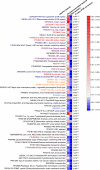The genome of the amoeba symbiont "Candidatus Amoebophilus asiaticus" reveals common mechanisms for host cell interaction among amoeba-associated bacteria
- PMID: 20023027
- PMCID: PMC2812958
- DOI: 10.1128/JB.01379-09
The genome of the amoeba symbiont "Candidatus Amoebophilus asiaticus" reveals common mechanisms for host cell interaction among amoeba-associated bacteria
Abstract
Protozoa play host for many intracellular bacteria and are important for the adaptation of pathogenic bacteria to eukaryotic cells. We analyzed the genome sequence of "Candidatus Amoebophilus asiaticus," an obligate intracellular amoeba symbiont belonging to the Bacteroidetes. The genome has a size of 1.89 Mbp, encodes 1,557 proteins, and shows massive proliferation of IS elements (24% of all genes), although the genome seems to be evolutionarily relatively stable. The genome does not encode pathways for de novo biosynthesis of cofactors, nucleotides, and almost all amino acids. "Ca. Amoebophilus asiaticus" encodes a variety of proteins with predicted importance for host cell interaction; in particular, an arsenal of proteins with eukaryotic domains, including ankyrin-, TPR/SEL1-, and leucine-rich repeats, which is hitherto unmatched among prokaryotes, is remarkable. Unexpectedly, 26 proteins that can interfere with the host ubiquitin system were identified in the genome. These proteins include F- and U-box domain proteins and two ubiquitin-specific proteases of the CA clan C19 family, representing the first prokaryotic members of this protein family. Consequently, interference with the host ubiquitin system is an important host cell interaction mechanism of "Ca. Amoebophilus asiaticus". More generally, we show that the eukaryotic domains identified in "Ca. Amoebophilus asiaticus" are also significantly enriched in the genomes of other amoeba-associated bacteria (including chlamydiae, Legionella pneumophila, Rickettsia bellii, Francisella tularensis, and Mycobacterium avium). This indicates that phylogenetically and ecologically diverse bacteria which thrive inside amoebae exploit common mechanisms for interaction with their hosts, and it provides further evidence for the role of amoebae as training grounds for bacterial pathogens of humans.
Figures




References
-
- Abd, H., B. Wretlind, A. Saeed, E. Idsund, K. Hultenby, and G. Sandstrom. 2008. Pseudomonas aeruginosa utilises its type III secretion system to kill the free-living amoeba Acanthamoeba castellanii. J. Eukaryot. Microbiol. 55:235-243. - PubMed
Publication types
MeSH terms
Substances
Associated data
- Actions
Grants and funding
LinkOut - more resources
Full Text Sources
Other Literature Sources
Molecular Biology Databases
Miscellaneous

